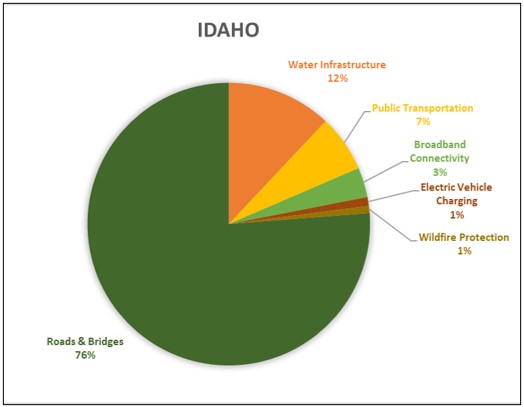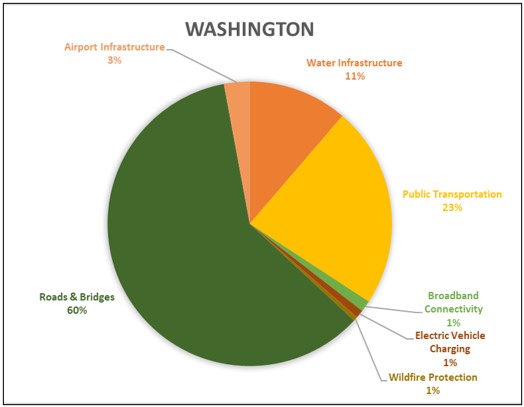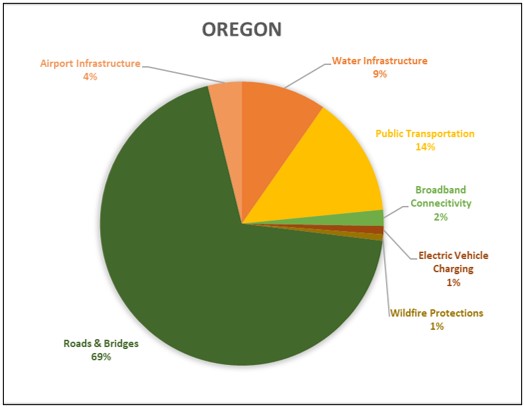What the Bipartisan Infrastructure Bill Means for the Pacific Northwest Water Industry
By Shannon Kronz, EIT, Civil Engineer, Brown and Caldwell
The United States Congress passed the Bipartisan Infrastructure package (HR 3684) on November 5, 2021. The Infrastructure package allocates $1.2 trillion towards new research, grant programs, and U.S. infrastructure modernization and allocates $55 billion to drinking water, wastewater, and stormwater infrastructure funding.
The Infrastructure package is the single-largest investment in the U.S. water industry history. The water industry funding focuses on improving access to safe drinking water, providing clean water for communities, protecting regional waters, and additional investments in the water industry. Improving access to safe drinking water includes upgrading lead services lines in low-income neighborhoods and communities of color. Providing clean water for communities includes upgrading the nation’s aging wastewater and stormwater infrastructure. Through the package, the Drinking Water and Clean Water State Revolving Funds will be able to address emerging contaminants of concern in drinking water and stormwater. Protecting regional waters includes investments in 12 federally recognized geographic programs and 28 federally recognized estuaries to restore vulnerable coastal areas and communities. Additional investments in water include funding for the Gulf of Mexico Hypoxia Task Force, Underground Injection Control Grants, and Permitting Class VI wells.
How will the Infrastructure Bill Affect the Stormwater Industry?
The Infrastructure Bill will provide funding to upgrade the United States’ aging stormwater infrastructure and programs to improve stormwater management. The legislation includes the following allocations for the stormwater industry:
- $14.65 billion over the next five years for to the Clean Water State Revolving Fund (CWSRF)
- $1 billion over the next five years for CWSRF grants focusing on emerging contaminants, such as PFAS in stormwater
- $1.4 billion over the next five years towards the U.S. EPA Sewer Overflow & Stormwater Reuse Municipal Grant Program
- $625 million over the next five years towards resiliency grants
- $625 million over the next five years for alternative source water pilot programs
- $500 million to the Healthy Streets program, which includes funding for the installation of permeable pavers
- $50 million for stormwater infrastructure planning/development and implementation grants
- $25 million for the Stormwater Infrastructure Technology Program to create five Stormwater Centers of Excellence
- $5 million toward the EPA’s Clean Watershed Needs Survey to help identify issues in the water industry
How will the Infrastructure Bill Affect the Pacific Northwest?
Idaho
The Infrastructure Bill will provide Idaho with $3.03 billion ($1,645 per person) in funding for infrastructure improvements. The figure below shows the breakdown.
Funding allocated for Idaho’s water infrastructure ($355 million) will improve access to clean drinking water, upgrade the State’s aging water infrastructure, and create resilient water systems in preparation for climate change. Currently, Idaho Falls, ID is one of the largest Western cities in the U.S. that does not meter the city water. Water infrastructure funding could provide assistance to install water meters throughout the city. The funding will also help cities across Idaho design and implement sustainable stormwater infrastructure. The funding will aid the City of Boise in wastewater infrastructure improvements and aquifer recharge. Additional grants will be available to fund infrastructure projects throughout Idaho, including $1 billion to replace culverts to improve fish passage for threatened and endangered species. Many culverts in Idaho are undersized, blocking fish, including Salmon and Steelhead, from traveling throughout the waterways.
Washington
The Infrastructure Bill will provide Washington with $8.59 billion ($1,115 per person) in total funding. The figure below shows the breakdown.
The State of Washington water infrastructure funding ($882 million) will provide access to clean drinking water and improve the environmental and aquatic health of the State’s waterways. The Puget Sound Geographic Program and the Columbia River Basin Geographic Program qualify under the Environmental Protection Agency’s National Estuary Program. The Puget Sound will receive $89 million for restoration and $79 million for the Colombia River Basin Geographic Program. Like Idaho, Washington plans to fix fish passage barriers that impact salmon and aquatic life. The funding includes allocations for the Habitat Restoration and Community Resilience Grants and the National Ocean and Coastal Security Fund Grants.
Oregon
The Infrastructure Bill will provide 5.36 billion ($1,265 per person) in total funding for infrastructure projects. The figure below shows the breakdown.
The State of Oregon plans to use the water infrastructure funds ($529 million) to replace lead pipelines in the drinking water distribution system and improve access to clean drinking water. Critical water infrastructure local programs in Oregon will receive some funding to aid projects currently underway in Hillsboro, Portland, and Gresham. Funding will work to ensure public drinking water and wastewater infrastructure are well-maintained. Tribal communities in Oregon will also receive federal funding to improve decade-old drinking water pipelines and pump systems.
Overall, the Infrastructure Bill will provide significant funding to repair, replace and upgrade the Pacific Northwest’s aging water infrastructure. The funding allocated will improve drinking water, wastewater, and stormwater infrastructure and management with the opportunity to increase resilience in our water systems, which will help protect the health and safety of the communities and environment.
Author:
Shannon Kronz, EIT, Civil Engineer, Brown and Caldwell
[email protected], (208) 389-7709
PNCWA Stormwater Committee Member
References
[1] https://www.estormwater.com/legislationgovernment-actions/infrastructure-bill-passes-house-impacts-storm-water-breakdown
[2] https://www.stormh2o.com/stormwater-management/press-release/21245551/congress-passes-1t- infra-structure-bill
[3] https://stormwater.wef.org/2021/09/major-u-s-infrastructure-package-to-address-stormwater-sector-needs/
[4] https://www.linkedin.com/pulse/whats-infrastructure-bill-stormwater-sector-nmsa/
[5] https://www.epa.gov/system/files/documents/2021-11/e-ow-bid-fact-sheet-final.508.pdf
[6] https://pacinst.org/the-u-s-infrastructure-plan-water-components/
[7] https://www.usnews.com/news/best-states/articles/2021-11-19/the-states-getting-the-most-money-from-the-infrastructure-bill
[8] https://smartasset.com/financial-advisor/biden-infrastructure-bill-spending-by-state
[9] https://www.idahoconservation.org/blog/infrastructure-bill-whats-in-it-for-idaho/
[10] https://pamplinmedia.com/msp/129-news/531678-425225-infrastructure-plan-pumps-money-into-oregons-drinking-water?wallit_nosession=1
[11] https://www.merkley.senate.gov/news/press-releases/merkley-secures-funding-vital-for-oregon-forest-health-environmental-improvements-and-water-infrastructure-in-senate-appropriations-bill
[12] https://www.oregonlive.com/pacific-northwest-news/2021/12/infrastructure-bill-may-ease-clean-water-crisis-for-warm-springs-other-tribes.html
